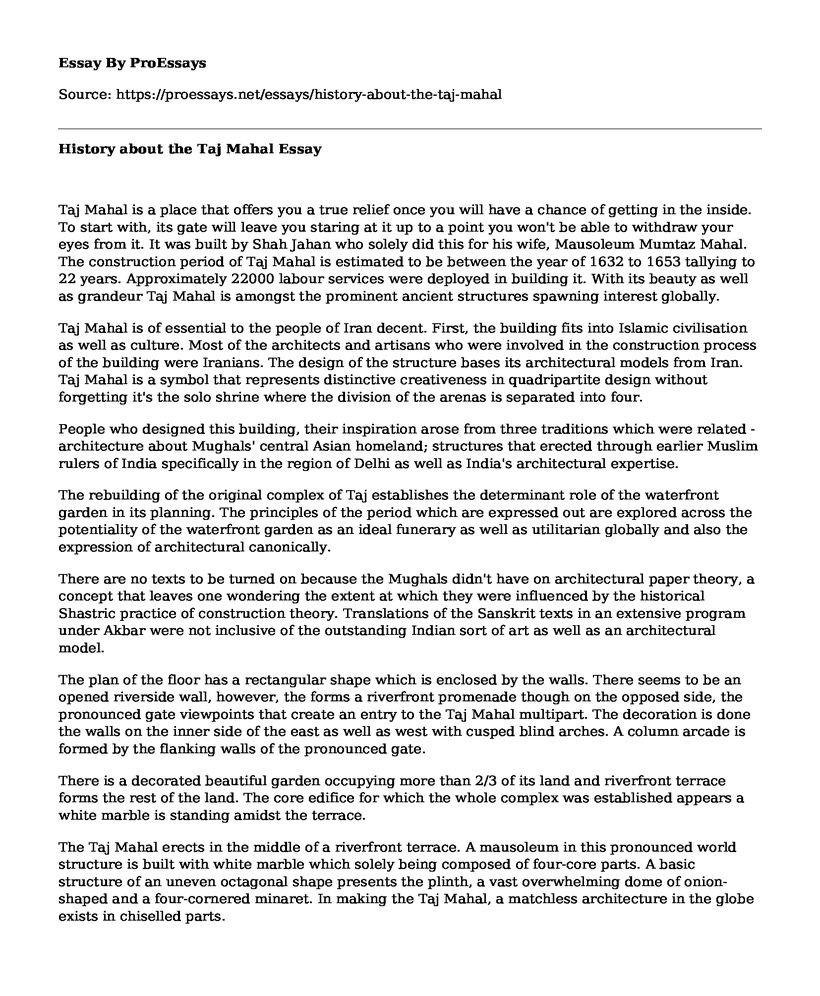Taj Mahal is a place that offers you a true relief once you will have a chance of getting in the inside. To start with, its gate will leave you staring at it up to a point you won't be able to withdraw your eyes from it. It was built by Shah Jahan who solely did this for his wife, Mausoleum Mumtaz Mahal. The construction period of Taj Mahal is estimated to be between the year of 1632 to 1653 tallying to 22 years. Approximately 22000 labour services were deployed in building it. With its beauty as well as grandeur Taj Mahal is amongst the prominent ancient structures spawning interest globally.
Taj Mahal is of essential to the people of Iran decent. First, the building fits into Islamic civilisation as well as culture. Most of the architects and artisans who were involved in the construction process of the building were Iranians. The design of the structure bases its architectural models from Iran. Taj Mahal is a symbol that represents distinctive creativeness in quadripartite design without forgetting it's the solo shrine where the division of the arenas is separated into four.
People who designed this building, their inspiration arose from three traditions which were related - architecture about Mughals' central Asian homeland; structures that erected through earlier Muslim rulers of India specifically in the region of Delhi as well as India's architectural expertise.
The rebuilding of the original complex of Taj establishes the determinant role of the waterfront garden in its planning. The principles of the period which are expressed out are explored across the potentiality of the waterfront garden as an ideal funerary as well as utilitarian globally and also the expression of architectural canonically.
There are no texts to be turned on because the Mughals didn't have on architectural paper theory, a concept that leaves one wondering the extent at which they were influenced by the historical Shastric practice of construction theory. Translations of the Sanskrit texts in an extensive program under Akbar were not inclusive of the outstanding Indian sort of art as well as an architectural model.
The plan of the floor has a rectangular shape which is enclosed by the walls. There seems to be an opened riverside wall, however, the forms a riverfront promenade though on the opposed side, the pronounced gate viewpoints that create an entry to the Taj Mahal multipart. The decoration is done the walls on the inner side of the east as well as west with cusped blind arches. A column arcade is formed by the flanking walls of the pronounced gate.
There is a decorated beautiful garden occupying more than 2/3 of its land and riverfront terrace forms the rest of the land. The core edifice for which the whole complex was established appears a white marble is standing amidst the terrace.
The Taj Mahal erects in the middle of a riverfront terrace. A mausoleum in this pronounced world structure is built with white marble which solely being composed of four-core parts. A basic structure of an uneven octagonal shape presents the plinth, a vast overwhelming dome of onion-shaped and a four-cornered minaret. In making the Taj Mahal, a matchless architecture in the globe exists in chiselled parts.
Amidst the riverfront terrace, the plinth is set which is surrounded by a superbly decorated border being tiled by use of white marble as well as red-stone sand. A geometric pattern was used in designing the border where rhombuses as well as regular and at the same time oblong flowers are combined in achieving this.
The mausoleum's plinth is built of white marble as well as constructed in a square-shaped which is topped using marble floor. The facade wall of the pedestal is divided into thirty-three frames each. Each of the frames is equal at the same time decked out using bas-relief, sunken rectangle as well as cusped blind curves that are encircled by use of inlaid black streaks. The plinth's corner forms an octagon similar to the cusped curved balconies on the corners. Slightly moving up midway the wall exist a crowned lower arc via an upper arch. The decorative elements found in every flame are similar like the Iwan. However, they lack arabesque calligraphy. For the frames, which have cusped arches they are blind-vaults. Similarly they have a similar shape as that of the Iwan but in this case its small in size. For every vault of the frame, exist a Jaali which is carved out of marble that produces light as well as air on the inner side of the chambers. By use of a similar pattern like that of Iwan, decorations of the ceilings of the vaults using Muqarnas are on view.
In the Mughal gardens water played a vital role. It's therefore, for this reason, the usage of water was placed in a systematized manner showing an exceptional feature. By use of the intricate network, distribution and bringing of water were done at every place.
Works Cited
Khan, Iftakhar Nadime. BLACK TAJ MAHAL: The Emperor's Missing Tomb. Black Taj Project, 2015.
Tillotson, G H. R. Taj Mahal. Cambridge, Mass: Harvard University Press, 2013. Internet resource.
Cite this page
History about the Taj Mahal. (2022, Nov 02). Retrieved from https://proessays.net/essays/history-about-the-taj-mahal
If you are the original author of this essay and no longer wish to have it published on the ProEssays website, please click below to request its removal:
- Gender, Race and Media
- The Man Who Wins Murder Case and Killed Minutes after Getting Freed
- Uncertainty, Ambiguity and Irony in Shakespeare's Macbeth Essay
- Defending the Right to Own Guns - Essay Sample
- Essay on Right to Liberty & Equity: Ensuring Fair Living for All
- Essay Sample on History and the Criminal Case of Aileen Wuornos
- Corrections: Last Step in Criminal Justice System - Essay Sample







